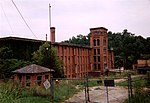Seneca, South Carolina
Cities in Oconee County, South CarolinaCities in South CarolinaPopulated places established in the 1870sSeneca, South CarolinaUse mdy dates from July 2023

Seneca is a city in Oconee County, South Carolina, United States. The population was 8,102 at the 2010 census. It is the principal city of the Seneca Micropolitan Statistical Area (population 74,273 at the 2010 census), an (MSA) that includes all of Oconee County, and that is included within the greater Greenville-Spartanburg-Anderson, South Carolina Combined Statistical Area (population 1,266,995 at the 2010 census). Seneca was named for the nearby Cherokee town of Isunigu, which English colonists knew as "Seneca Town".
Excerpt from the Wikipedia article Seneca, South Carolina (License: CC BY-SA 3.0, Authors, Images).Seneca, South Carolina
West Railroad Street,
Geographical coordinates (GPS) Address Nearby Places Show on map
Geographical coordinates (GPS)
| Latitude | Longitude |
|---|---|
| N 34.684166666667 ° | E -82.955833333333 ° |
Address
West Railroad Street 170
29678
South Carolina, United States
Open on Google Maps





